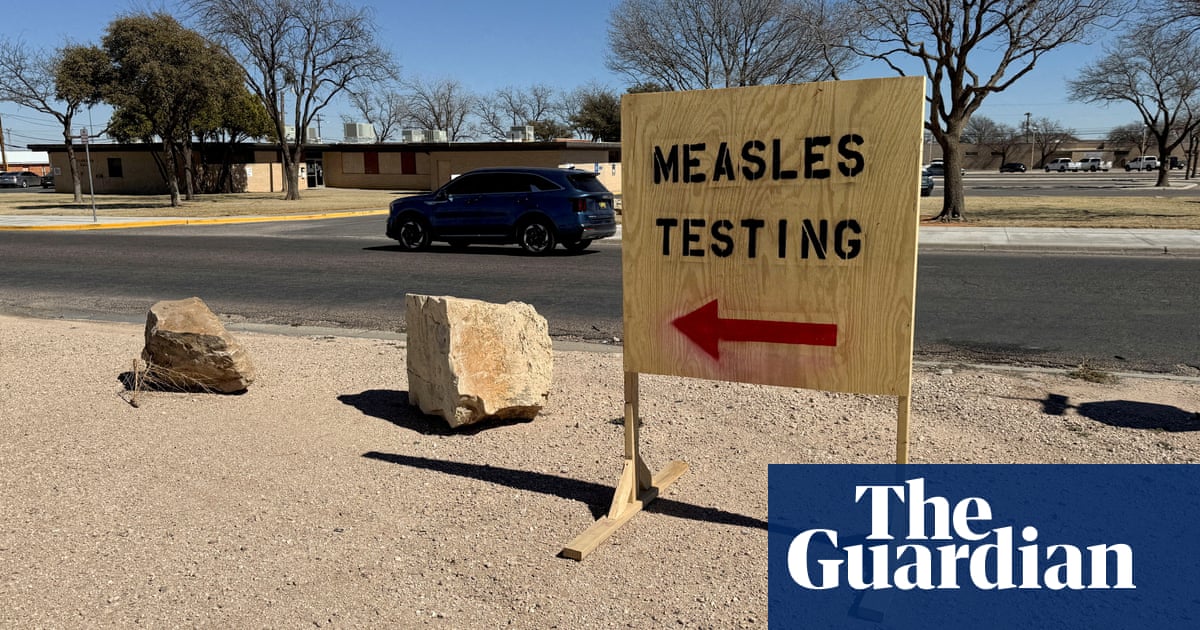ThemeaslesoutbreakinTexasis showing signs of slowing, though other states are seeing more cases and health officials are warning against complacency as the US continues to experience high rates of measles amid falling vaccination rates.
It has been a handful of days since anyone in Lubbock,Texas, has tested positive, and there are no known measles hospitalizations at the children’s hospital in the city, which has also cared for children from nearby Gaines county.
“We’re really cautiously optimistic,” said Katherine Wells, the director of Lubbock PublicHealth.
It takes 42 days with no new measles cases to declare a community’s outbreak is over, so Lubbock is not out of the woods yet, she said.
Wastewateranalysesindicate infections may be going down in El Paso and Lubbock, said Anthony Maresso, a professor of molecular virology and microbiology at the Baylor College of Medicine who is part of a team monitoring wastewater pathogens in 15 cities across Texas.
But this doesn’t mean the danger has passed. Wells and Maresso warned against letting up on momentum against the deadly disease outbreak.
“We’re still seeing measles cases in El Paso. We’re seeing measles cases in some of the other states in the central United States. It really just takes one person in a car who’s infectious to introduce it into another community,” Wells said.
Texasannouncedsix new cases on Friday for a total of 728 this year. A total of 94 people have been hospitalized in the Texas outbreak and two school-agedchildrendied.
The west Texas outbreak has also spread to a handful of other states. Officials in New Mexicoannouncedon Thursday the tallyhad risento 76 cases, and they confirmed that thedeathof an adult in March was indeed caused by measles.
There have been58 casesin Kansas and17 casesin Oklahoma, in addition to other states seeing separate outbreaks.
The US now has a total of 1,024 confirmed measles cases, which makes 2025 thesecond-worst yearalready for measles since the virus was declared eliminated from the US in 2000.
The outbreak may be losing steam in west Texas because ofsuccessfulvaccination campaigns and because many people who were not vaccinated have now been infected.
Although children have suffered the bulk of cases, abouttwo-thirdsof the cases in El Paso are among adults. Officials recommend that anyone in the outbreak areas unsure of their vaccination status should get a measles booster shot.
YetRobert F Kennedy Jr, the head of the US Department of Health and Human Services (HHS), has repeatedly spreadmisinformationabout the measles vaccine.
“You have consistentlybeenunderminingthe measles vaccine,” Chris Murphy, a Democratic senator from Connecticut, told Kennedy at a 14 May hearing on the HHS budget.
“You told the public that the vaccine wanes very quickly. You went on the Dr Phil show and said that the measles vaccine was never fully tested for safety. You said there’s fetal debris in the measles vaccine,” Murphy said.
“All true. All true,” Kennedy said.
“None of that is true,” Murphy responded.
“Of course it’s true,” Kennedy said.
Statements like these undermine the public’s confidence in vaccines at a critical time, experts said.
Communities that have fallen below the 95% threshold for community immunity (also known as herd immunity) should run vaccination campaigns now, before new outbreaks begin, both Wells and Maresso said.
“The easiest thing you can do, in this case, is just put out an educational campaign around closing the vaccine gap,” said Maresso. “If we had vaccine coverage above 95%, we would not see these outbreaks. It’s that effective.”
Wells added that “what we’ve learned here is that there’s a lot of communities across the US that have these lower vaccination rates.”
Summer tends to be a high season for travel, and travelers may import measles from a state or country experiencing an outbreak into at-risk communities like these, Wells said.
“We see lots of movement in the summer,” Wells continued. “So you see lots of people traveling internationally to places that might have endemic measles, that can reintroduce it into any vulnerable community across the United States.”
Monitoring wastewater can serve as anearly warning signof a budding outbreak, especially in places with low vaccination rates.
The Texas wastewater monitoring was funded by the state legislature through the Texas Epidemic Public Health Institute (TEPHI), created during the Covid pandemic “as kind of a Texas version of the CDC”, Maresso said.
“We saw a signal for measles in the wastewater before any of this outbreak discussion in Texas or really before it started to become a headline worldwide,” Maresso said.
“If we are seeing the earliest stages of an outbreak, it gives us a lead time to warn public health folks: ‘There are cases. You’re probably not seeing them on the clinical radar, but there are cases in your community, and you should expect that you’re going to start to see cases – and if they’re not vaccinated, it’s going to get worse.’”
Local leaders should prepare for measles outbreaks now, Wells said.
“Some of it’s education to your physicians, your schools, your daycares, about measles, what the rash looks like, just so that people are paying attention to that,” she said.
Public health officials should also understand their testing capabilities and the logistics of, for instance, transporting specimens to laboratories.
That way, “you’re prepared and it’s at the front of your mind – not sitting back in some dusty textbook,” Wells said.
But all of that work requires funding. While public health departments have frequently worked on shoestring budgets, the Trump administration has made funding even more precarious.
“There was a clawback of the Covid funding that was available to local health departments,” Wells said. And with other federal funds for public health, “it’s even harder to follow exactly what’s going on,” Wells noted.
“I’m concerned. It’s so important for us to have local public health departments that can respond to things like measles or whatever the next outbreak is.”
